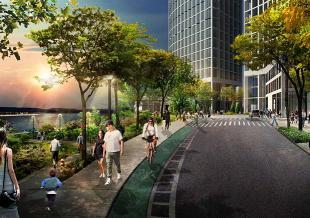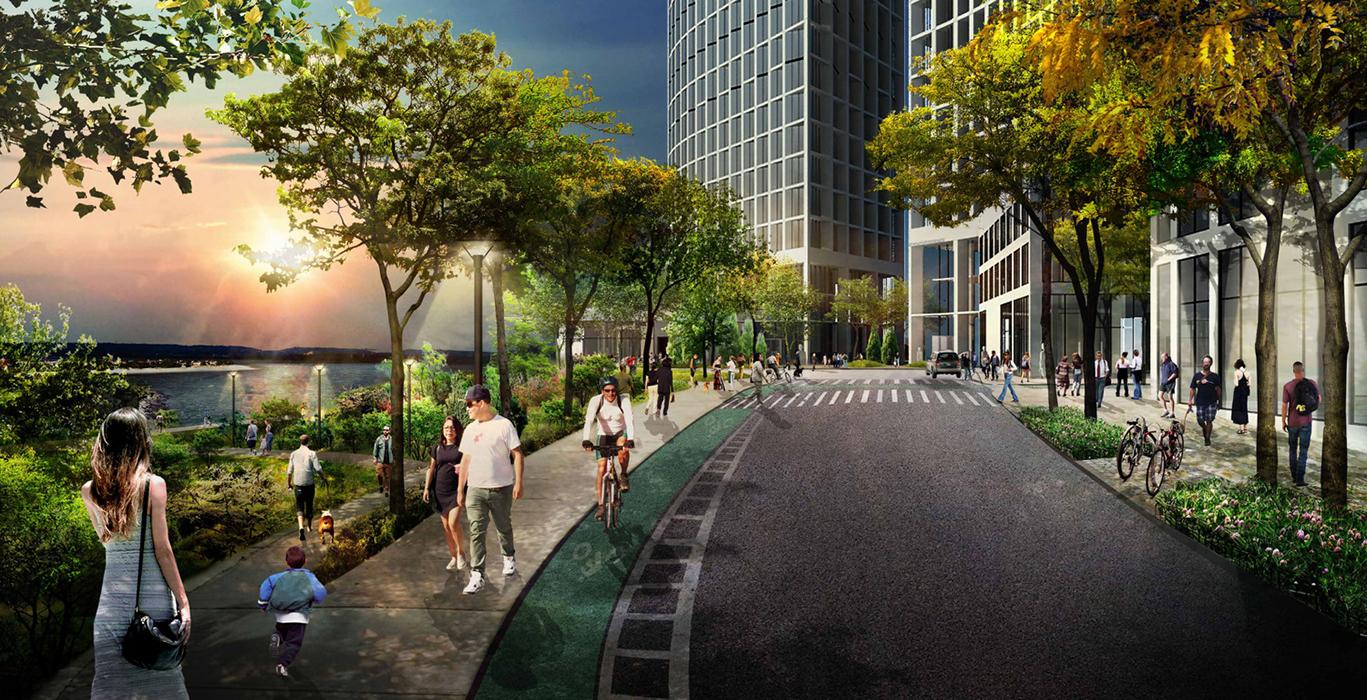
Climate Action: Resilience Master Planning

 Courtesy STUDIO V Architecture
Courtesy STUDIO V Architecture
This week in our continuing series showcasing how engineers and scientists can play a key role in addressing the short- and long-term challenges of climate change, we look at the goals and process behind resilience master planning, including Thornton Tomasetti’s Resilience Toolkit, a comprehensive assessment of each project to understand the potential risks and vulnerabilities.
Resilience Master Planning goes beyond designing a single building, bridge or infrastructure system and seeks to foster entire communities at different scales. Whether revitalizing an existing college campus, reimagining an industrial site or establishing a new neighborhood outside of an urban hub, resilience master plans keep an eye toward the future and are a prime opportunity to apply a resilient and sustainable framework.
Adaptation Goals
We begin the master planning process with specific resilience goals in mind:
Build in redundancy that safeguards critical infrastructure systems against climate hazards and protect property to minimize damages and losses. Designing strong buildings and systems that can withstand significant loads is a familiar concept for all Thornton Tomasetti designers, whether we're utilizing traditional code-based methods or recovery-based engineering approaches. We often reiterate the importance of designing adaptability and redundancy into resilience strategies to account for uncertainty, and that is key to successful master planning, as well. Many of the uncertainties we encounter on building- or site-level projects can be exacerbated at the master plan level, such as:
- How long will the project take? How will construction be phased?
- How much will this cost? Is there enough funding to see it through to the end?
- What are the existing site conditions and vulnerabilities? How do we account for them?
- What will the future site conditions be? Will changing conditions impact operations and functionality of the facilities?
For the Sunnyside Yard project in Queens, for example, the final project construction phase is planned for decades in the future — likely after most of the project team members have retired! How do we account for such long phasing and inherent uncertainty in the design? Thornton Tomasetti’s Climate Action approach shows "Here's How" we handle such uncertainty, and these are the type of challenges we are uniquely equipped to handle with our diverse expertise and project experience in-house.
Prevent interruptions to critical businesses and neighborhood facilities and promote public safety during and after hazardous events. Master plans are about communities, which means residents need safe means of egress prior to an emergency (climate or otherwise), places of refuge during an event and a restored sense of "normalcy" after an event. Critical facilities must maintain continual operations while local business, organizations and community services should be able to resume operations with minimal downtime. While we have worked with co-consultants to design resilient strategies for hazard event planning, Thornton Tomasetti has a robust suite of in-house capabilities (i.e., Protective Design & Security, mobility planning, crowd modeling) that allows us to address these project needs.
Enhance quality of life by providing new public amenities and equitable access. Maximize co-benefits to take advantage of natural surroundings and promote biodiversity and public health. Improving community wellness and quality of life standards are often motivating factors for initiating the master planning process. Our Climate Action approach reflects the importance of decreasing operational and embodied carbon and the benefits of nature-based solutions. These co-benefits can be maximized in the master plan with proper coordination between disciplines and integration of strategies. The Resilience team has worked closely with our colleagues in Protective Design and Sustainability to achieve these goals on projects in recent years.
Resilience Toolkit
With these goals in mind, we then perform a climate risk and resilience assessment to understand the hazards and vulnerabilities. This process looks a little different depending on the project scale (campus vs. city) and type (revitalization vs. new development). Regardless, we take a systems-based approach to identify the key performance gaps and opportunities for improvement and develop strategies that minimize the potential adverse impacts of future climate change to people, assets and area-wide disruption. These recommendations take the form of a Resilience Toolkit, which is tailored specifically for each project.
While each component has unique considerations, the Resilience Toolkit provides a holistic approach to incorporate these strategies throughout the master plan, including the following:
- Future-focused, resilient design criteria appropriate for the useful life of each component. For example, critical infrastructure (i.e., utilities) and base foundation structures may have higher design criteria and redundancy requirements than components that have a shorter useful life (i.e., building HVAC systems, landscaping elements) and will be replaced. Furthermore, we anticipate that projections and technologies will improve in the future and recommend adaptable design for future developments.
- Strategies that address the key vulnerabilities identified in the risk and resilience assessment. An emergency preparedness plan for one community may incorporate a flash flood monitoring program, while another may be better suited to publicize coastal flood evacuation routes, depending on the assessment results.
- Recommendations for prioritizing implementation based on the proposed project phasing. While not every measure can be implemented immediately, clients may opt to address "low hanging fruit" or tackle the biggest areas of vulnerability during the early phases of the project.
Through resilience master planning, we envision how neighborhood transformation can occur that not only revitalizes local communities and strengthens the potential for future development, but also adapts to climate change by utilizing the natural surroundings. Our master planning capabilities continue to grow as we tap into our in-house capabilities and work with partners who are passionate about tackling the challenge of climate change.
Climate change is one of the biggest challenges facing our society. And because it affects everyone, it demands our creativity, passion and collaboration to build a better, more enduring world. See how Thornton Tomasetti is one of the only firms with the expertise to help you think holistically about a range of steps to address climate change.












